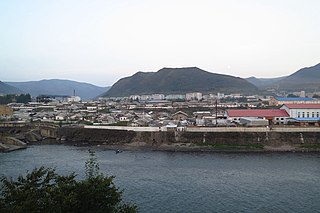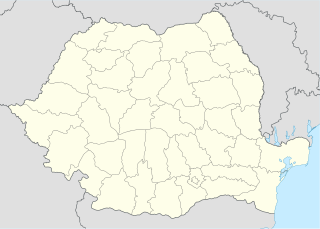Related Research Articles

Primorsky Krai, informally known as Primorye and translated in full as Maritime Territory, is a federal subject of Russia, located in the Far East region of the country and is a part of the Far Eastern Federal District. The city of Vladivostok is the administrative center of the krai, as well as the largest city in the Russian Far East. The krai has the largest economy among the federal subjects in the Russian Far East, and a population of 1,956,497 as of the 2010 Census.

Hyesan is a city in the northern part of Ryanggang province of North Korea. It is a hub of river transportation as well as a product distribution centre. It is also the administrative centre of Ryanggang Province. As of 2008, the population of the city is 192,680.

Chŏngjin is the capital of North Korea's North Hamgyong Province (함경북도) and the country's third largest city. It is sometimes called the City of Iron.

Kanggye is the provincial capital of Chagang, North Korea and has a population of 251,971. Because of its strategic importance, derived from its topography, it has been of military interest from the time of the Joseon Dynasty (1392-1910).

Mining in Japan is minimal because Japan does not possess many on-shore mineral resources. Many of the on-shore minerals have already been mined to the point that it has become less expensive to import minerals. There are small deposits of coal, oil, iron and minerals in the Japanese archipelago. Japan is scarce in critical natural resources and has been heavily dependent on imported energy and raw materials. There are major deep sea mineral resources in the seabed of Japan. This is not mined yet due to technological obstacles for deep sea mining.

Hŏch'ŏn County is a county in South Hamgyŏng province, North Korea. It was created after the division of Korea, from portions of Tanch'ŏn and P'ungsan.
Gold mining in Alaska, a state of the United States, has been a major industry and impetus for exploration and settlement since a few years after the United States acquired the territory in 1867 from the Russian Empire. Russian explorers discovered placer gold in the Kenai River in 1848, but no gold was produced. Gold mining started in 1870 from placers southeast of Juneau, Alaska.

The mineral mining industry is a crucial piece of the Economy of Niger. Exports of minerals consistently account for 40% of exports.

Mining in the United Kingdom produces a wide variety of fossil fuels, metals, and industrial minerals due to its complex geology. In 2013, there were over 2,000 active mines, quarries, and offshore drilling sites on the continental land mass of the United Kingdom producing £34bn of minerals and employing 36,000 people.
The Cavnic mine is a large mine located in the northwest of Romania in Maramureș County, 26 km southwest of Baia Mare and 576 km north of the capital, Bucharest. Cavnic represents one of the largest polymetallic reserves in Romania having significant reserves of gold, silver, copper, lead and zinc amounting to 20 million tonnes of ore grading 1g/t gold, 30g/t silver, 2% lead, 3% zinc and 1% copper. The resources amount to 640,000 oz of gold, 19.2 million oz of silver, 400,000 tonnes of lead metal, 600,000 tonnes of zinc metal and 200,000 tonnes of copper metal.

The Kalimashi 1 mine is a large mine located near the village Kalimash in northern Albania in Kukës County, 80 kilometres (50 mi) north-east of the capital, Tirana. Kalimashi 1 represents the fourth largest chromium reserve in Albania and one of the largest in Europe having estimated reserves of 1.9 million tonnes of ore grading 20% chromium metal. The mine is part of the Kukës Massif, a 108 square kilometres (42 sq mi) area which has a rock thickness between 4 kilometres (2.5 mi) and 6 kilometres (3.7 mi) and contains 54 verified chromium deposits and occurrences. The deposit has been explored to depths of up to 300 metres (980 ft) and the geological reserves amount to 6.8 million tonnes grading 21.4% chromium metal.

The Kalimashi 3 mine is a large mine located near the village Kalimash in northern Albania in Kukës County, 80 kilometres (50 mi) north-east of the capital, Tirana. Kalimashi 3 represents the fifth largest chromium reserve in Albania and one of the largest in Europe having estimated reserves of 1.6 million tonnes of ore grading 20% chromium metal. The mine is part of the Kukës Massif, a 108 square kilometres (42 sq mi) area which has a rock thickness between 4 kilometres (2.5 mi) and 6 kilometres (3.7 mi) and contains 54 verified chromium deposits and occurrences. The deposit has been explored to depths of up to 300 metres (980 ft) and the geological reserves amount to 6.8 million tonnes grading 21.4% chromium metal.

The Përroi Batrës mine is a large mine located near the village Kalimash in northern Albania in Kukës County, 80 kilometres (50 mi) north-east of the capital, Tirana. Përroi Batrës represents one of the largest chromium reserve in Albania and one of the largest in Europe having estimated reserves of 1.2 million tonnes of ore grading 20% chromium metal. The mine is part of the Kukës Massif, a 108 square kilometres (42 sq mi) area which has a rock thickness between 4 kilometres (2.5 mi) and 6 kilometres (3.7 mi) and contains 54 verified chromium deposits and occurrences. The deposit has been explored to depths of up to 300 metres (980 ft) and the geological reserves amount to 6.8 million tonnes grading 21.4% chromium metal.

The Rodu mine is a large open pit mine in the west of Romania in Alba County, 73 km west of Alba Iulia and 467 km north-west of the capital, Bucharest. Rodu represents a large gold deposit with estimated reserves of 0.81 million oz of gold and 1.7 million oz of silver. The project is owned by the Toronto-based company Gabriel Resources.
Mining in North Korea is important to the country's economy. North Korea is naturally abundant in metals such as magnesite, zinc, tungsten, and iron; with magnesite resources of 6 billion tonnes, particularly in the North and South Hamgyong Province and Chagang Province. However, often these cannot be mined due to the acute shortage of electricity in the country, as well as the lack of proper tools to mine these materials and an antiquated industrial base. Coal, iron ore, limestone, and magnesite deposits are larger than other mineral commodities. Mining joint ventures with other countries include China, Canada, Egypt, and South Korea.
The Holdong mine is one of the largest gold mines in North Korea and in the world. The mine is located in the south of the country in North Hwanghae Province. The mine has estimated reserves of 63.2 million oz of gold and 149.8 million oz of silver. The mine also has reserves amounting to 520 million tonnes of ore grading 0.35% copper metal and 266 million tonnes of ore grading 26% iron metal.
The Hyesan mine is one of the largest silver mines in North Korea and in the world. The mine is located in the north of the country in Ryanggang Province. The mine has estimated reserves of 3.07 million oz of gold and 921.6 million oz of silver. The mine also has reserves amounting to 160 million tonnes of ore grading 0.35% copper, 3.2% lead and 3.6% zinc.
The Komdok mine is one of the largest lead and zinc mines in North Korea and in the world. The mine is located in Kumgol-1dong, Tanchon. The mine has estimated reserves of 266 million tonnes of ore 0.88% lead and 4.21% zinc.
The Taehung Youth Hero Mine is one of the largest magnesium mines in North Korea and in the world. The mine is located in the center of the country in South Hamgyong Province. The mine has estimated reserves of 826 million tonnes of ore 46.77% magnesium. However, facilities have become antiquated and an unstable electricity supply limits the full exploitation of the resources.
The Mannyŏn mine is one of the largest tungsten mines in North Korea and in the world. The mine is located in the center of the country in South Hamgyong Province. The mine has estimated reserves 20 million tonnes of ore grading 0.65% tungsten.
References
- 1 2 3 "The mining industry of North Korea". chinapost.com.tw. 2009. Retrieved 2013-07-03.
- ↑ "Sangnong". transphoto.org. Retrieved 2021-04-10.